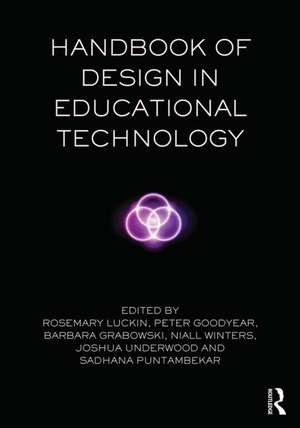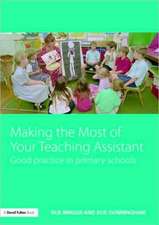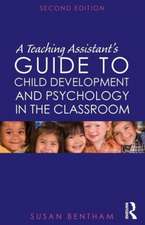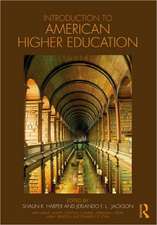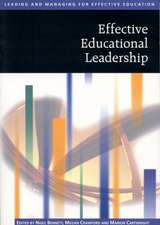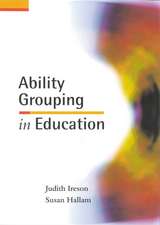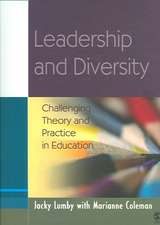Handbook of Design in Educational Technology
Editat de Rosemary Luckin, Sadhana Puntambekar, Peter Goodyear, Barbara L. Grabowski, Joshua Underwood, Niall Wintersen Limba Engleză Paperback – 25 iul 2013
The volume is organized into the following four sections: Theory, Design, Implementation, and Evaluation.
The more than forty chapters reflect the international and interdisciplinary nature of the educational technology design research field.
| Toate formatele și edițiile | Preț | Express |
|---|---|---|
| Paperback (1) | 634.50 lei 6-8 săpt. | |
| Taylor & Francis – 25 iul 2013 | 634.50 lei 6-8 săpt. | |
| Hardback (1) | 1471.35 lei 6-8 săpt. | |
| Taylor & Francis – 25 iul 2013 | 1471.35 lei 6-8 săpt. |
Preț: 634.50 lei
Preț vechi: 882.26 lei
-28% Nou
Puncte Express: 952
Preț estimativ în valută:
121.41€ • 127.22$ • 100.37£
121.41€ • 127.22$ • 100.37£
Carte tipărită la comandă
Livrare economică 11-25 aprilie
Preluare comenzi: 021 569.72.76
Specificații
ISBN-13: 9780415807357
ISBN-10: 0415807352
Pagini: 528
Ilustrații: 30 tables
Dimensiuni: 174 x 246 x 33 mm
Greutate: 0.98 kg
Ediția:New.
Editura: Taylor & Francis
Colecția Routledge
Locul publicării:Oxford, United Kingdom
ISBN-10: 0415807352
Pagini: 528
Ilustrații: 30 tables
Dimensiuni: 174 x 246 x 33 mm
Greutate: 0.98 kg
Ediția:New.
Editura: Taylor & Francis
Colecția Routledge
Locul publicării:Oxford, United Kingdom
Cuprins
Foreword by Rosemary Luckin Part I. Foundations Design in Educational Technology: Foundations by Peter Goodyear Chapter 1 The Practice of Educational/Instructional Design by Peggy A. Ertmer, Martin L. Parisio, and Dewa Wardak Chapter 2 Principles for Design and Evaluation of Learning Spaces by Mike Keppell and Matthew Riddle Chapter 3 The Ecology of Resources: A Theoretically Grounded Framework for Designing Next Generation Technology Rich Learning by Rosemary Luckin, Wilma Clark, and Joshua Underwood Chapter 4 Design-Based Research—Designing as Research by Peter Reimann Chapter 5 Understanding and Analysing 21st Century Skills Learning Outcomes Using Assessments by Patrick Griffin, My Van Bui and Esther Care Part II. Design Methods Design in Educational Technology: The Design Process by Joshua Underwood and Rosemary Luckin Chapter 6 Using Technology Probes to Understand Educational Design Spaces by Madeline Balaam Chapter 7 Iterative Context Engineering to Inform the Design of Intelligent Exploratory Learning Environments for the Classroom byManolis Mavrikis, Sergio Gutierrez-Santos, Eirini Geraniou, Richard Noss and Alex Poulovassilis Chapter 8 Sketch-Ins: A Method for Participatory Design in TEL by Brock Craft Chapter 9 Issues and Methods for Involving Young People in Design by Judy Robertson, Judith Good, Katy Howland, and Andrew Macvean Chapter 10 Orchestrating Classroom CSCL: A Multi-level Pattern Approach for Design and Enactment by L. P. Prieto, S. Villagrá-Sobrino, Y. Dimitriadis, I. Jorrín-Abellán Chapter 11 Empowering teachers to design learning resources with metacognitive interface elements by Judy Kay, Sabina Kleitman, and Roger Azevedo Chapter 12 Meta-Design: Empowering All Stakeholder as Co-Designers by Gerhard Fischer Chapter 13 Designing for Seamless Learning by Chee-Kit Looi and Lung-Hsiang Wong Chapter 14 Putting the Ecology of Resources Design Framework to Use with Language Learners’ Contexts by Rosemary Luckin, Wilma Clark, Joshua Underwood Chapter 15 Designing Affective and Cognitive Educational Interaction by Benedict du Boulay Chapter 16 Activity Theory and Educational Technology Design by Daisy Mwanza-Simwami Chapter 17 SNaP! Re-using, sharing and communicating designs and design knowledge using Scenarios, Narratives, and Patterns by Yishay Mor Chapter 18 Going Native: Autoethnography as a Design Tool by Margot Duncan Part III. Implementation Design in Educational Technology: Implementation Challenges by Barbara Grabowski and Niall Winters Chapter 19 A Developmental Study for the Design of Creative Problem Solving Support System by Cheol Il Lim, Wan Chul Lim, and Miyoung Hong Chapter 20 Case-Based Learning for Anesthesiology: Enhancing Dynamic Decision-Making Skills through Cognitive Apprenticeship and Cognitive Flexibility by Ikseon Choi, Yi-Chun Hong, Hyojin Park, Yunseok Lee Chapter 21 Scaffolding Learning in an LMS: Learning to Write an Action Research Proposal by Priya Sharma and Alice E. Anderson Chapter 22 Considering the Design of an Electronic Progress-Monitoring System by Simon Hooper, Charles Miller, and Susan Rose Chapter 23 Designing for Awareness: Purposeful Interactions in the Next Generation of Distance Education by Jennifer A. Maddrell and Gary R. Morrison Chapter 24 Learning with Facebook Group—Interaction in Action by Gila Kurtz, Hagit Meishar-Tal, and Efrat Pieterse Chapter 25 Designing for Learning with Tangible Technologies by Sara Price and Paul Marshall Chapter 26 An Introduction to Technology Enhanced Learning Design in Postgraduate Medical Education by Niall Winters Chapter 27 The Convergence of Informal Learning and Formal Education in a Ubiquitous Environment by Heeok Heo, Il-Hyun Jo, Kyu Yon Lim, Hyeon Woo Lee, and Soonshik Suh Chapter 28 Design for Museum Learning: Visitor-Constructed Trails Using Mobile Technologies by Kevin Walker Chapter 29 A Blended Instructional Design Approach to Cyberlearning that Supports Persons with Disabilities by Marilyn P. Arnone, Jennifer T. Ellis, and Derrick L. Cogburn Chapter 30 Cloud-based eLearning for Higher Education: Realizing the Potential by Alexander Romiszowski and Elvis Otamere Chapter 31 Role of Web-Based Technologies in Framing Teaching Presence by Fengfeng Ke and Li Zhu Part IV. EvaluationWhat Are Students Learning and How: Methods for Assessing Learning by Sadhana Puntambekar Chapter 32 Measuring What Matters: Technology and the Design of Assessments that Support Learning by James W. Pellegrino Chapter 33 Educational Design Research in the 21st Century by William A. Sandoval Chapter 34 Lights, Camera, Learn: When the Set is as Important as the Actors by Iris Tabak Chapter 35 Bidirectional artifact analysis: A method for analyzing digitally mediated creative processes by Erica Halverson and Alecia Magnifico Chapter 36 Mass Collaboration and Learning by Ulrike Cress Chapter 37 Emerging Technologies for Young Children: Evaluating the Learning Benefits of New Forms of Interaction by Andrew Manches Chapter 38 Insight into Teaching and Learning: The Complex Face of Video Research by Mary J. Leonard and Sharon J. Derry Chapter 39 Basic Concepts and Techniques in Social Work Analysis by Christophe Reffay and Alejandra Martínez-Monés Chapter 40 Seeing to Understand: Using Visualizations to Understand Learning in Technology-Rich Learning Environments by Cindy E. Hmelo-Silver, Rebecca Jordan, and Suparna Sinha Chapter 41 Using Process Mining for Understanding Learning by Peter Reimann and Kalina Yacef Chapter 42 Self-Regulated Learning Engines: Software Technologies for Researching and Promoting Self-Regulated Learning by Philip H. Winne Chapter 43 Assessing Socio-Emotional Learning Around Educational Technologies by Carolyn Penstein Rosé
Notă biografică
Rosemary Luckin is Professor of Learner Centered Design at the London Knowledge Lab, Institute of Education, University of London, UK.
Sadhana Puntambekar is Professor of Learning Sciences in the Educational Psychology department at the University of Wisconsin-Madison, USA.
Peter Goodyear is an Australian Laureate Fellow and Professor of Education at the University of Sydney, Australia.
Barbara Grabowski is Professor Emerita of Education at The Pennsylvania State University, USA.
Joshua Underwood is an independent Learner Centred Design consultant and PhD candidate at the London Knowledge Lab, Institute of Education, University of London, UK.
Niall Winters is a Senior Lecturer in Learning Technologies for Development at the London Knowledge Lab, Institute of Education, University of London, UK.
Sadhana Puntambekar is Professor of Learning Sciences in the Educational Psychology department at the University of Wisconsin-Madison, USA.
Peter Goodyear is an Australian Laureate Fellow and Professor of Education at the University of Sydney, Australia.
Barbara Grabowski is Professor Emerita of Education at The Pennsylvania State University, USA.
Joshua Underwood is an independent Learner Centred Design consultant and PhD candidate at the London Knowledge Lab, Institute of Education, University of London, UK.
Niall Winters is a Senior Lecturer in Learning Technologies for Development at the London Knowledge Lab, Institute of Education, University of London, UK.
Descriere
The Handbook of Design in Educational Technology provides up-to-date, comprehensive summaries and syntheses of recent research pertinent to the design of information and communication technologies to support learning. Readers can turn to this handbook for expert advice about each stage in the process of designing systems for use in educational settings; from theoretical foundations to the challenges of implementation, the process of evaluating the impact of the design and the manner in which it might be further developed and disseminated.
